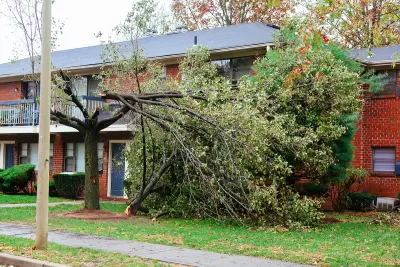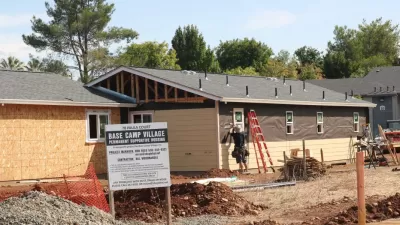There are many proposed ways to mitigate the property insurance cost crisis. They all require action from federal or state governments.

This article is reprinted from Shelterforce Magazine.
In March 2012, McAllen, Texas, was hit with a once-in-a-generation disaster, a supercell thunderstorm that battered the city with 75mph wind gusts, flash floods, and hailstones the size of baseballs in the middle of the afternoon. Afterward, experts put total damages at $500 million, with insured damages hitting $260 million.
For Affordable Homes of South Texas Inc. (AHSTI), a nonprofit developer, home builder, and mortgage company, the end of the storm was the beginning of a new problem. “What we found was that as a result of the damages that were left behind, a lot of our insurance premiums were either doubling or tripling or just not being renewed at all,” says Robert Calvillo, AHSTI’s executive director. “Carriers were leaving the area. Our existing [mortgage] customers . . . started having payment problems, delinquencies rising.”
Calvillo, who came to the affordable housing world after working in banking, suspected there might be creative ways to restrain AHSTI’s skyrocketing insurance costs. Calvillo’s first move was to try to sign up with an existing insurance company as a captive insurance agency, an arrangement similar to a franchise, in which an insurance agency is wholly owned by the entities it insures. But to Calvillo’s surprise, AHSTI was rebuffed.
“They wouldn’t even pay attention to us,” Calvillo remembers. “When I told them the agency would be owned by a nonprofit, they just they couldn’t wrap their head around it.”
Calvillo returned to the conventional insurance market and poked around. With premiums rising, he expected to find a competitive market, but what he found was the opposite—a rigid system, rife with inefficiency. “What we found was that some of the agents in the area, particularly . . . those type of agents that that are tied to one carrier, were really kind of stuck,” he says. “They couldn’t shop around. They couldn’t look for a better price.”
Calvillo saw opportunity, and decided to start his own firm, which he named Hope Insurance Agency. Other independent agents thought he was wasting his time, and predicted Hope would fold in a year or two. “The difference is that we decide what carriers we want to represent,” says Calvillo. “So as an example, we have approximately 12 carriers that will cover a typical home that we build. So if this one doesn’t want to do it because they’ve had losses or they only want to cover homes that are brick and masonry versus hardboard or whatever their appetite is, we can shop around. And so what we found was immediately . . . premiums are going back to where they were prior to the hailstorm and even lower than that.”
Almost a decade later, Hope is thriving. It currently has over 1,200 policies in force; approximately 60 percent of them are homeowners policies, the vast majority of which cover low- to moderate-income homeowners. Aside from its ability to shop between carriers, Calvillo attributes Hope’s success to the fact that its five agents are salaried rather than commission-based, and to the extensive industry experience of Hope’s former CEO, Rosie Ovalle (over 40 years in the insurance business) and its present one, Laura Rangel (over 20 years of experience). The benefits of AHSTI’s independent agency have proven to be durable; Calvillo estimates they’ve seen only a 30 percent increase in property insurance premiums in each of the past two years, a time during which many affordable housing properties have seen much larger increases.
A 30 percent increase is still a significant burden for most community developers, however, and a reminder that, while AHSTI has found a way to exploit inefficiencies in the system, it’s still working from inside that system, which is deeply and perhaps fundamentally flawed. The past several years have been punishing for many property owners, especially providers of affordable housing, who are required by their investors and lenders to carry high levels of insurance. They can’t simply raise rents to offset rising costs; even if they’re not restrained by statute, it’s not compatible with their mission of providing affordable housing. With some developers facing one-year increases as large as 450 percent, there’s widespread interest—some might say desperation—for potential solutions. There are fixes in the works—but will they come soon enough?
Reinsurance reform
Reinsurance is a huge factor in recent premium increases. Sometimes called an invisible trade, reinsurance is essentially insurance for insurers; just as property owners buy insurance to protect themselves from a fire or earthquake, insurers purchase reinsurance to protect themselves from a large-scale disaster that could lead to a catastrophic number of claims. When you pay your insurance premium, a substantial part of it is passed through to reinsurers.
In some states, a large majority of consumer insurance premiums are due to reinsurance costs; Birny Birnbaum, director for the Texas-based Center for Economic Justice, notes that “in Florida, it’s not uncommon to see an insurance company give 75 percent of its premium away” to reinsurers. In California, where some developers have seen 450 percent year-over-year increases in their premiums, Birnbaum speculates that “out of that 450 percent, maybe 50 percent is due to . . . inflation, and 400 percent is due to the reinsurance.”
Reinsurers can be ruthless when it comes to raising their rates. Spikes in global reinsurance prices don’t even seem to be predictably tied to increases in exposure, says Birnbaum. He refers, for example, to a graph of reinsurance costs known as the Guy Carpenter ROL Index. This graph shows spikes in costs after years that features heavy losses, followed by steady declines. “The rates spike after major events even though the risk was present when the insurers and reinsurers wrote the business,” he wrote in an email. “Did risk increase 50% from 2020 to 2024? . . . Did risk decline by 2/3s from 1993 to 2000? This is a market that, instead of pricing for future risk, seeks to recoup losses from bad years and then forgets about risk when there aren’t major events for a few years.”
Readily available reinsurance has enabled undercapitalized insurance companies to enter markets like California and Florida and essentially gamble on making a quick buck. “If you’re giving away 90 percent of your premiums to the reinsurance company, you can think of it as leverage,” explains Birnbaum. “You’ve got insurance companies that come in, particularly in Florida and Louisiana, and they roll the dice. They say, ‘We’re just going to buy tremendous amounts of reinsurance. The state is going to allow us to charge whatever we want . . . And if a big, big event hits, we walk away.’”
In 2023, the amount of capital in the reinsurance market hit a record $729 billion, which is why Birnbaum says, “in terms of affordable housing, reinsurance [reform] really would be the most immediate way to provide relief.”
But that’s easier said than done. The industry-leading reinsurance firms are based in Germany and Switzerland. You could look at this arrangement as beneficial—U.S. insurers are essentially exporting their risk, and when there’s a large-scale disaster in the U.S., the massive injection of foreign capital from reinsurance is a vital economic lifeline. But it does have its downside. While insurers in the U.S. are subject to state regulators and insurance law, reinsurance firms overseas are not.
What can the U.S. do to curb reinsurance costs? While it can’t regulate the companies directly, the U.S. government has intervened before. After 9/11, reinsurers stopped covering terrorism, forcing domestic insurers to follow suit. This abrupt reversal had a chilling effect on many industries, such as real estate and transportation. At the time, President George W. Bush attributed a lot of the post-9/11 recession to the withdrawal of reinsurance. Congress soon passed the Terrorism Risk Insurance Act, which required insurers to write policies covering terrorism, and also pledged federal funds as an emergency backstop in the event of a large-scale disaster.
There’s currently a bill working its way through the Senate that takes a similar approach. Written by California Rep. Adam Schiff, the INSURE Act sets up a federal reinsurance program that would absorb the top layer of risk—so, for example, policies from high-risk state insurers of last resort won’t have to get expensive private reinsurance. Instead, the federal government will price that reinsurance at the expected cost of claims, plus administrative costs. This will also take a lot of pressure off the rest of the market by removing that highest stratum of risk from private insurers’ books, which should further reduce prices. The act also sets aside a huge amount of government money for loss prevention and mitigation to blunt the ongoing effects of climate change, and to create means-tested financial assistance for property owners who are having difficulty affording insurance. (That assistance could take the form of loss mitigation, a buyout and relocation, or a simple cash transfer.) Finally, the act would collect granular data about the consumer insurance market. (Insurance regulators have long refused to collect this data, and so have very little actionable information about what’s happening in their markets.)
“The INSURE Act is actually a pretty comprehensive approach to addressing the problems,” Birnbaum says, noting that he’s bullish on the bill’s prospects of making it into law since its market-based logic should appeal to both sides of the aisle. But he also notes that it’s not a cure-all. “Reinsurance is one big piece of it, but reinsurance alone can’t solve the problem.”
State fallbacks
In most states, there are technically solutions already in place to handle situations like today’s out-of-control insurance market. Hard-hit states like Florida, Texas, and California have residual insurance markets for consumers who can’t get conventional insurance. These residual markets, like the FAIR plan in California, or Citizens in Florida, are intended as a backstop to handle spillover from what’s essentially a market failure. The problem is that most of them don’t work. Take California’s FAIR plan, for instance. The FAIR Plan is run by insurers and offers bare-bones policies covering only a few types of damage. There are not, however, any effective price controls; FAIR policies cost more than twice as much as private insurance.
Many experts say this kind of dysfunction could only be by design. “That’s the bizarre thing,” says Birnbaum. “These residual markets, they’re set up to punish policyholders who can’t get insurance in the voluntary market. The concept is that, well, we don’t want these residual markets competing with the private markets. So, you know, we’ll make them punitive. It’s absurd. It’s like you’re rewarding the private market for limiting coverage. It feels like saying we’re going to make the Affordable Care Act coverage punitive to consumers because they can’t get [medical] coverage through the voluntary market. Nobody would suggest something idiotic like that. But that’s the narrative that the property casualty insurers have gotten [through and] their narrative is adopted by insurance regulators around the country.”
Florida’s residual market, Citizens Insurance, has the opposite problem. Insurance through Citizens is actually much cheaper than buying it through a private company—37.5 to 44 percent cheaper, according Citizens. That’s because the Florida legislature froze state rates in 2010, and later restricted annual increases to 10 percent and then 12 percent. It sells both residential and commercial policies, and with rates frozen, is outcompeting the private market. Here the problem seems to be that it’s working so well that private companies resent the competition and have complained. In response, in December 2022, Florida’s state government began actively purging tens of thousands of people from Citizens’ rolls, canceling renewals for anyone who can access comparable private insurance that isn’t more than 20 percent more expensive than Citizens. The government has seemingly even sought to undermine Citizens’ reputation. Gov. Ron DeSantis told reporters recently that Citizens was “insolvent,” an alarming accusation that prompted calls for congressional hearings and was soon proved false.
So why are state insurers of last resort like Citizens and FAIR run like this—as safety nets that don’t actually offer much safety? Birnbaum and others point out that the insurance industry maintains a powerful lobby. Also relevant is that states take in a lot of money from the tax on insurance premiums.
“Premium tax is something on the order of 1.8 to 2 percent of premium,” says Birnbaum. “So it’s a gigantic revenue source for states.”
Most problems with the insurance system are quite complex, but here the remedy is fairly simple. Insurance is regulated on the state level, so state legislatures could pass legislative fixes, as they did to tamp down rates in Florida. (They would then have to hold more firm against industry complaints than Florida did.) In some areas, they already have. In Texas the state legislature has made it “much less punitive” for consumers who get insurance coverage for wind damage through the state, notes Birnbaum. “It’s simply up to the legislature. But the insurance industry fights it because they don’t want meaningful competition.”
Political pressure on regulators has to mount to a point that it outweighs industry influence.
There are relevant examples from the past, too. When Birnbaum was in a regulator in Texas in the early 1990s, he recalls, “there was a worker’s comp crisis. Companies were leaving the market. So the state created a public workers comp insurer, and that public worker’s comp insurer grew to something like 65–75 percent of the market. Well, no one complained because it was helping businesses. And eventually the private market came back. But, you know, it wasn’t a punitive approach. . . they offered a competitive product.”
The key factor here is that political pressure on regulators has to mount to a point that it outweighs industry influence. And with premiums skyrocketing around the country, it seems only a matter of time before many states reach that tipping point. In the meantime, many are looking at smaller-scale options.
Exempting nonprofits from sales tax on insurance would be a quick way to take some of the pressure off, says Daniel Elkin of cdcb, a Texas nonprofit developer. He says sales tax on insurance can run as high as $50,000 per building. “That just happens to be a weird part of the tax code that says, yes, you’re exempt from sales tax on physical materials, but services? No,” says Elkin. They are working with some state legislators to change that. “If it’s $50,000 a complex, it doesn’t solve the problem,” he says, “but it’s a lot of relief. And it seems like a pretty simple fix that nobody really loses on. I mean, I understand it’s less tax revenue. There’s repercussions for that. But at least for us, we get to keep affordable units in the market. And it’s not like the insurance companies are taking a hit.”
FULL STORY: Read Full Story

Planetizen Federal Action Tracker
A weekly monitor of how Trump’s orders and actions are impacting planners and planning in America.

Map: Where Senate Republicans Want to Sell Your Public Lands
For public land advocates, the Senate Republicans’ proposal to sell millions of acres of public land in the West is “the biggest fight of their careers.”

Restaurant Patios Were a Pandemic Win — Why Were They so Hard to Keep?
Social distancing requirements and changes in travel patterns prompted cities to pilot new uses for street and sidewalk space. Then it got complicated.

California Homeless Arrests, Citations Spike After Ruling
An investigation reveals that anti-homeless actions increased up to 500% after Grants Pass v. Johnson — even in cities claiming no policy change.

Albuquerque Route 66 Motels Become Affordable Housing
A $4 million city fund is incentivizing developers to breathe new life into derelict midcentury motels.

DC Area County Eliminates Bus Fares
Montgomery County joins a growing trend of making transit free.
Urban Design for Planners 1: Software Tools
This six-course series explores essential urban design concepts using open source software and equips planners with the tools they need to participate fully in the urban design process.
Planning for Universal Design
Learn the tools for implementing Universal Design in planning regulations.
Heyer Gruel & Associates PA
JM Goldson LLC
Custer County Colorado
City of Camden Redevelopment Agency
City of Astoria
Transportation Research & Education Center (TREC) at Portland State University
Camden Redevelopment Agency
City of Claremont
Municipality of Princeton (NJ)





























